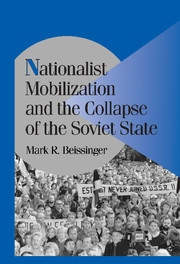Book contents
- Frontmatter
- Contents
- Illustrations
- Tables
- Acknowledgments
- 1 FROM THE IMPOSSIBLE TO THE INEVITABLE
- 2 THE TIDE OF NATIONALISM AND THE MOBILIZATIONAL CYCLE
- 3 STRUCTURING NATIONALISM
- 4 “THICKENED” HISTORY AND THE MOBILIZATION OF IDENTITY
- 5 TIDES AND THE FAILURE OF NATIONALIST MOBILIZATION
- 6 VIOLENCE AND TIDES OF NATIONALISM
- 7 THE TRANSCENDENCE OF REGIMES OF REPRESSION
- 8 RUSSIAN MOBILIZATION AND THE ACCUMULATING “INEVITABILITY” OF SOVIET COLLAPSE
- 9 CONCLUSION: NATIONHOOD AND EVENT
- Appendix I PROCEDURES FOR APPLYING EVENT ANALYSIS TO THE STUDY OF SOVIET PROTEST IN THE GLASNOST' ERA
- Appendix II SOURCES FOR THE COMPILATION OF EVENT DATA IN A REVOLUTIONARY CONTEXT
- Index
- Titles in the series
8 - RUSSIAN MOBILIZATION AND THE ACCUMULATING “INEVITABILITY” OF SOVIET COLLAPSE
Published online by Cambridge University Press: 18 November 2009
- Frontmatter
- Contents
- Illustrations
- Tables
- Acknowledgments
- 1 FROM THE IMPOSSIBLE TO THE INEVITABLE
- 2 THE TIDE OF NATIONALISM AND THE MOBILIZATIONAL CYCLE
- 3 STRUCTURING NATIONALISM
- 4 “THICKENED” HISTORY AND THE MOBILIZATION OF IDENTITY
- 5 TIDES AND THE FAILURE OF NATIONALIST MOBILIZATION
- 6 VIOLENCE AND TIDES OF NATIONALISM
- 7 THE TRANSCENDENCE OF REGIMES OF REPRESSION
- 8 RUSSIAN MOBILIZATION AND THE ACCUMULATING “INEVITABILITY” OF SOVIET COLLAPSE
- 9 CONCLUSION: NATIONHOOD AND EVENT
- Appendix I PROCEDURES FOR APPLYING EVENT ANALYSIS TO THE STUDY OF SOVIET PROTEST IN THE GLASNOST' ERA
- Appendix II SOURCES FOR THE COMPILATION OF EVENT DATA IN A REVOLUTIONARY CONTEXT
- Index
- Titles in the series
Summary
Struggles over words … consist in trying to carry out what musicians call inversions of the chord, in trying to overturn the ordinary hierarchy of meanings in order to constitute as a fundamental meaning, as the root note of the semantic chord, a meaning that had hitherto been secondary, or, rather, implied, thus putting into action a symbolic revolution which may be at the root of political revolutions.
Pierre Bourdieu, In Other Words: Essays Towards a Reflexive SociologyThree Decembers tell the basic story behind the final years of the Soviet state. In December 1989 the Soviet Union was a deeply troubled country. By that time, the Soviet economy was in a state of marked decline, secessionist revolts had spread to the Baltic, Georgia, Western Ukraine, Moldova, Armenia, and Azerbaijan, nationalist violence had become an entrenched aspect of life in multiple regions of the country, and the Soviet Union's East European communist allies – under the impact of tidal effects emanating from the USSR – had been overturned with astounding rapidity. The possibility that the Soviet Union could fall apart and strategies for preventing this from happening had already been discussed on several occasions within the Politburo. Opinion polls showed that 53 percent of the Soviet population allowed the possibility that some republics might leave the USSR. But whereas the prospect of a few republics leaving had grown conceivable and even increasingly acceptable to the public, the notion that the country would totally disintegrate and disappear from the map still seemed implausible to the vast majority of Soviet citizens and foreign observers alike.
- Type
- Chapter
- Information
- Nationalist Mobilization and the Collapse of the Soviet State , pp. 385 - 442Publisher: Cambridge University PressPrint publication year: 2002

